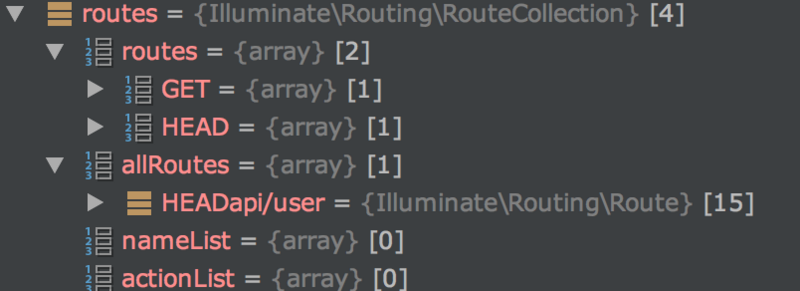这篇文章将为大家详细讲解有关Laravel中如何使用路由,文章内容质量较高,因此小编分享给大家做个参考,希望大家阅读完这篇文章后对相关知识有一定的了解。
入口
Laravel启动后,会先加载服务提供者、中间件等组件,在查找路由之前因为我们使用的是门面,所以先要查到Route的实体类。
注册
第一步当然还是通过服务提供者,因为这是laravel启动的关键,在 RouteServiceProvider 内加载路由文件。
protected function mapApiRoutes()
{
Route::prefix('api')
->middleware('api')
->namespace($this->namespace) // 设置所处命名空间
->group(base_path('routes/api.php')); //所得路由文件绝对路径
}首先require是不可缺少的。因路由文件中没有命名空间。 Illuminate\Routing\Router 下方法
protected function loadRoutes($routes)
{
if ($routes instanceof Closure) {
$routes($this);
} else {
$router = $this;
require $routes;
}
}随后通过路由找到指定方法,依旧是 Illuminate\Routing\Router 内有你所使用的所有路由相关方法,例如get、post、put、patch等等,他们都调用了统一的方法 addRoute
public function addRoute($methods, $uri, $action)
{
return $this->routes->add($this->createRoute($methods, $uri, $action));
}之后通过 Illuminate\Routing\RouteCollection addToCollections 方法添加到集合中
protected function addToCollections($route)
{
$domainAndUri = $route->getDomain().$route->uri();
foreach ($route->methods() as $method) {
$this->routes[$method][$domainAndUri] = $route;
}
$this->allRoutes[$method.$domainAndUri] = $route;
}添加后的结果如下图所示

实例化
依旧通过反射加载路由指定的控制器,这个时候build的参数$concrete = App\Api\Controllers\XxxController
public function build($concrete)
{
// If the concrete type is actually a Closure, we will just execute it and
// hand back the results of the functions, which allows functions to be
// used as resolvers for more fine-tuned resolution of these objects.
if ($concrete instanceof Closure) {
return $concrete($this, $this->getLastParameterOverride());
}
$reflector = new ReflectionClass($concrete);
// If the type is not instantiable, the developer is attempting to resolve
// an abstract type such as an Interface of Abstract Class and there is
// no binding registered for the abstractions so we need to bail out.
if (! $reflector->isInstantiable()) {
return $this->notInstantiable($concrete);
}
$this->buildStack[] = $concrete;
$constructor = $reflector->getConstructor();
// If there are no constructors, that means there are no dependencies then
// we can just resolve the instances of the objects right away, without
// resolving any other types or dependencies out of these containers.
if (is_null($constructor)) {
array_pop($this->buildStack);
return new $concrete;
}
$dependencies = $constructor->getParameters();
// Once we have all the constructor's parameters we can create each of the
// dependency instances and then use the reflection instances to make a
// new instance of this class, injecting the created dependencies in.
$instances = $this->resolveDependencies(
$dependencies
);
array_pop($this->buildStack);
return $reflector->newInstanceArgs($instances);
}这时将返回控制器的实例,下面将通过url访问指定方法,一般控制器都会继承父类 Illuminate\Routing\Controller ,laravel为其设置了别名 BaseController
public function dispatch(Route $route, $controller, $method)
{
$parameters = $this->resolveClassMethodDependencies(
$route->parametersWithoutNulls(), $controller, $method
);
if (method_exists($controller, 'callAction')) {
return $controller->callAction($method, $parameters);
}
return $controller->{$method}(...array_values($parameters));
}Laravel通过controller继承的callAction去调用子类的指定方法,也就是我们希望调用的自定义方法。
public function callAction($method, $parameters)
{
return call_user_func_array([$this, $method], $parameters);
}关于Laravel中如何使用路由就分享到这里了,希望以上内容可以对大家有一定的帮助,可以学到更多知识。如果觉得文章不错,可以把它分享出去让更多的人看到。
免责声明:本站发布的内容(图片、视频和文字)以原创、转载和分享为主,文章观点不代表本网站立场,如果涉及侵权请联系站长邮箱:is@yisu.com进行举报,并提供相关证据,一经查实,将立刻删除涉嫌侵权内容。